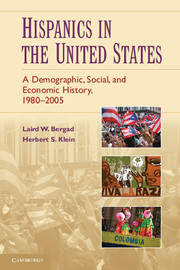Book contents
- Frontmatter
- Contents
- List of Graphs, Tables, and Maps
- Introduction
- 1 Immigration to the United States to 1980
- 2 The Hispanic Population to 1980
- 3 Population Growth and Dispersion, 1980–2005
- 4 The Demography of the Hispanic Population
- 5 Wealth and Poverty
- 6 Educational Attainment
- 7 Citizenship, the Latino Electorate, and Voter Participation
- 8 Occupational Structures, Employment, and Unemployment
- 9 English Language Abilities and Domestic Usage
- 10 Hispanic Business Ownership
- 11 Race
- 12 Endogamous and Exogamous Marriage Patterns among Latino Household Heads
- 13 Conclusion
- Bibliography
- Index
- References
7 - Citizenship, the Latino Electorate, and Voter Participation
Published online by Cambridge University Press: 05 June 2012
- Frontmatter
- Contents
- List of Graphs, Tables, and Maps
- Introduction
- 1 Immigration to the United States to 1980
- 2 The Hispanic Population to 1980
- 3 Population Growth and Dispersion, 1980–2005
- 4 The Demography of the Hispanic Population
- 5 Wealth and Poverty
- 6 Educational Attainment
- 7 Citizenship, the Latino Electorate, and Voter Participation
- 8 Occupational Structures, Employment, and Unemployment
- 9 English Language Abilities and Domestic Usage
- 10 Hispanic Business Ownership
- 11 Race
- 12 Endogamous and Exogamous Marriage Patterns among Latino Household Heads
- 13 Conclusion
- Bibliography
- Index
- References
Summary
Between 1980 and 2005 the absolute number of citizens of Latino origin in the United States nearly tripled from about 11 million to nearly 30 million. About 81% of this increase was because of births in the United States, and 19% was because of naturalization among the foreign-born. Yet, despite this increase in the actual number of citizens, the surge in migration to the United States from Latin America and the Caribbean after 1980 resulted in a declining percentage of all Latinos who were citizens from 80% in 1980 to 71% in 2005. This immigration resulted in a more than fourfold increase in the absolute number of Latinos who were not citizens of the United States from nearly 3 million in 1980 to over 12 million in 2005. If we consider the total citizen population of the United States, in 1980, about 5% were Latinos; by 2005 this percentage had increased to 11%.
The anti-immigrant sentiment, which has swept through the United States from the mid-1990s, exemplified by the passing of Proposition 187 in California in November 1994, led to a fairly significant increase in the yearly rate of naturalization among Latinos during the 1990s. There were over 1.2 million foreign-born naturalized Latino citizens in 1980 and over 4.7 million in 2005. Latino foreign-born residents who achieved citizenship through naturalization increased at about 5% annually during the 1980s, and this rate surged to 7% yearly between 1990 and 2000. However, between 2000 and 2005 the annual rate of naturalization increase among foreign-born Latinos fell to about 4% each year.
- Type
- Chapter
- Information
- Hispanics in the United StatesA Demographic, Social, and Economic History, 1980–2005, pp. 237 - 275Publisher: Cambridge University PressPrint publication year: 2010



